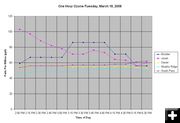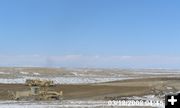

One Hour Average
One Hour Ozone Average for air quality monitors in Sublette County on Tuesday, March 18, 2008. Chart based on data gathered from WYDEQ air quality monitors as displayed on the WYDEQ website, www.wyvisnet.com. Note that WYDEQ says this is raw data that has not been quality control checked for accuracy.
|


Jonah Webcam
The Jonah ozone monitor reached 103 ppb around 2:00 PM on Tuesday. It is possible that heavy equipment working near the sampling monitor may be skewing the data at this location (Pinedale Online speculation).
|
|
Ozone levels in Sublette County again on the rise
WY DEQ officials give presentation to the Sublette County Commissioners about water and ozone concerns
by Pinedale Online!
March 18, 2008
Ozone levels at the Jonah air quality monitor topped 103 ppb at 2:00 PM on Tuesday, then have been decreasing. Levels at the Boulder monitor reached 86 ppb at 3:15 PM. This chart has been created by Pinedale Online from manual monitoring of the WYDEQ website, www.wyvisnet.com, and air quality monitors.
Wyoming DEQ has not issued an ozone health advisory for today.
____________________________________________________
Editor's Comment: Pinedale Online did not find out that WYDEQ Water & Air Quality and Wyoming Oil and Gas Commission representatives were going to speak to the County Commissioners in Pinedale until 15 minutes before their meeting. - Dawn Ballou, Editor
____________________________________________________
Wyoming DEQ officials met with the Sublette County Commissioners Tuesday morning to apprise them of water and air quality issues. Below is a report by Sue Sommers on that presentation.
DEQ Presentation on Water and Air Quality
County Commissioners’ Meeting
Tuesday, March 18, 2008
By Sue Sommers
The Wyoming Department of Environmental Quality (WYDEQ), represented by five staff members including Director John Corra, spent more than an hour addressing the issues of water monitoring and air quality before the County Commissioners this morning. Most of the discussion centered on water quality. Some new information about ozone and gas field emissions came to the fore. The general impression given was that of a state regulatory agency with the ability to collect data, but without the teeth to do much about it.
WYDEQ’s John Wagner, Water Quality Division Administrator, opened the presentation with groundwater monitoring, specifically how WYDEQ is keeping track of water well contamination on the Anticline and Jonah gas fields. Ongoing monitoring of industrial, domestic and stock wells currently shows that one of three industrial wells that had been over standards for benzene remains in remediation. There are 73 industrial wells with hydrocarbon detections. No contamination was found in the 72 domestic and stock water wells tested.
WYDEQ suspects that contamination of industrial water wells is caused by the absence of backflow preventers during drilling. The use of backflow preventers and other “best management practices” can be recommended by WYDEQ, but the agency does not currently have the rulemaking authority to require them. Compliance with such practices can be enforced only by the Bureau of Land Management (BLM) and willing operators. WYDEQ is working with the Environmental Protection Agency (EPA) and BLM to try to put these practices into the final Environmental Impact Statement for the Pinedale Anticline.
Surface water monitoring was briefly covered. The Sublette County Conservation District (SCCD) has been reporting data to the Pinedale Anticline Working Group (PAWG) since 2001 and continues to monitor 8 sites along the New Fork River for chemical, physical and biological changes. No impacts have been noted thus far. Commissioner John Linn suggested that WYDEQ groundwater data be consolidated with SCCD surface water data. The latest results from the SCCD studies is available at http://www.blm.gov/wy/st/en/field_offices/Pinedale/pawg/DataResults.html
The monitoring and remediation of commercial water disposal pits sparked extensive discussion. WYDEQ has jurisdiction only over commercial disposal facilities. Otherwise it becomes involved only when groundwater or surface water is affected. Pits on leased sites on state or private ground are overseen by the Oil & Gas Conservation Commission. The BLM is in charge of pits on BLM land.
WDEQ regulates five pits: the Anticline pit, the Calpet pit, the McGinnis (Exxon/Mobil) pit, and the inactive Newpark and Ball pits. The Newpark pit has unresolved remediation issues. The Ball pit is the oldest and most problematic. It is the only pit without bonded operators (this pit opened prior to the time when bonds became necessary). WYDEQ and the private owners are struggling to find the money to do the remediation. John Wagner pointed out that WYDEQ has limited authority over disposal pits unless the statute were to be changed.
Carmel Kail asked why WYDEQ’s authority could not be strengthened by creating more stringent rules, as other states have done. She pointed out that the Oil & Gas Conservation Commission has tougher rules than WDEQ. Further, the Wyoming Legislature could change state statutes. John Corra conceded that WDEQ would like to tighten up its rules and standards and that this could be done, but he also stated that the Legislature is ultimately in charge of WYDEQ’s direction.
WYDEQ’s Dave Finley, Air Quality Administrator, provided an overview of the causes of high levels of ozone in our air recently. After running through all of the possibilities, including intrusion from the stratosphere, the most likely source was “locally formed” ozone. Finley felt that pollution coming from outside the valley might account for only 5 to 10 percent of the problem.
Most of the conditions that cause high levels of ozone are not controllable: temperature inversion, low wind, lots of snow cover, and plenty of sunshine. The only controllable elements are the amounts of NOx (nitrous oxide) and VOCs (volatile organic compounds) in the air. The high ozone alerts have occurred even though cumulative levels of both NOx and VOCs have come down somewhat since 2004 and 2005 (charts were not provided for years prior to gas field development). VOCs have decreased more than NOx due to state regulation of VOCs starting in 1997. WYDEQ expects ozone advisories to continue for the next 2 or 3 years.
Finley explained that WYDEQ has been working with willing operators to create an inventory of emissions in order to anticipate and hopefully prevent problems. The agency is also looking to strengthen its rules, but could only regulate NOx emissions if the Legislature expands its regulatory power.
Commissioner Joel Bousman urged WYDEQ to work on upgrading its groundwater monitoring and requirements for disposal pits. He also felt WYDEQ should pursue more regulatory options regarding air quality. Bousman stated that the County Commission stood ready to partner with WYDEQ to improve conditions.
John Corra said that WYDEQ would try to return in a few weeks with more information to present to the public
|

